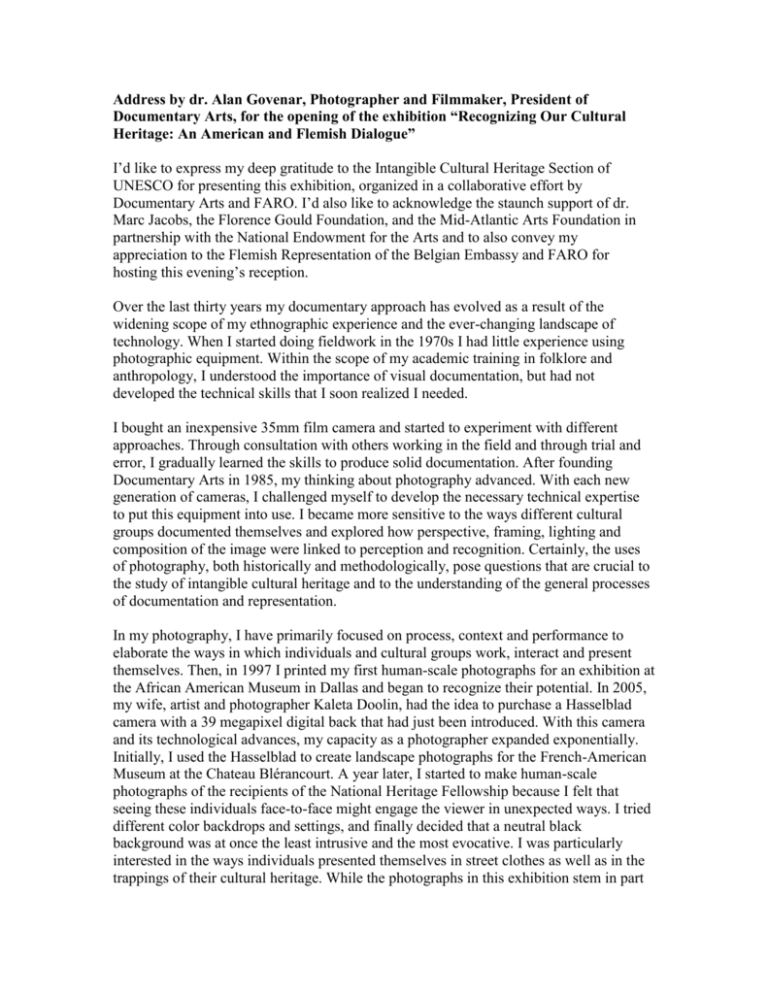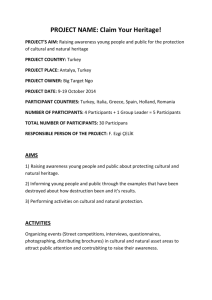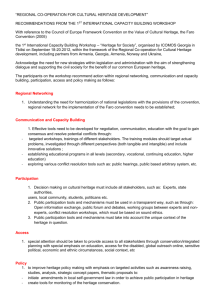Over the last thirty years my documentary approach has
advertisement

Address by dr. Alan Govenar, Photographer and Filmmaker, President of Documentary Arts, for the opening of the exhibition “Recognizing Our Cultural Heritage: An American and Flemish Dialogue” I’d like to express my deep gratitude to the Intangible Cultural Heritage Section of UNESCO for presenting this exhibition, organized in a collaborative effort by Documentary Arts and FARO. I’d also like to acknowledge the staunch support of dr. Marc Jacobs, the Florence Gould Foundation, and the Mid-Atlantic Arts Foundation in partnership with the National Endowment for the Arts and to also convey my appreciation to the Flemish Representation of the Belgian Embassy and FARO for hosting this evening’s reception. Over the last thirty years my documentary approach has evolved as a result of the widening scope of my ethnographic experience and the ever-changing landscape of technology. When I started doing fieldwork in the 1970s I had little experience using photographic equipment. Within the scope of my academic training in folklore and anthropology, I understood the importance of visual documentation, but had not developed the technical skills that I soon realized I needed. I bought an inexpensive 35mm film camera and started to experiment with different approaches. Through consultation with others working in the field and through trial and error, I gradually learned the skills to produce solid documentation. After founding Documentary Arts in 1985, my thinking about photography advanced. With each new generation of cameras, I challenged myself to develop the necessary technical expertise to put this equipment into use. I became more sensitive to the ways different cultural groups documented themselves and explored how perspective, framing, lighting and composition of the image were linked to perception and recognition. Certainly, the uses of photography, both historically and methodologically, pose questions that are crucial to the study of intangible cultural heritage and to the understanding of the general processes of documentation and representation. In my photography, I have primarily focused on process, context and performance to elaborate the ways in which individuals and cultural groups work, interact and present themselves. Then, in 1997 I printed my first human-scale photographs for an exhibition at the African American Museum in Dallas and began to recognize their potential. In 2005, my wife, artist and photographer Kaleta Doolin, had the idea to purchase a Hasselblad camera with a 39 megapixel digital back that had just been introduced. With this camera and its technological advances, my capacity as a photographer expanded exponentially. Initially, I used the Hasselblad to create landscape photographs for the French-American Museum at the Chateau Blérancourt. A year later, I started to make human-scale photographs of the recipients of the National Heritage Fellowship because I felt that seeing these individuals face-to-face might engage the viewer in unexpected ways. I tried different color backdrops and settings, and finally decided that a neutral black background was at once the least intrusive and the most evocative. I was particularly interested in the ways individuals presented themselves in street clothes as well as in the trappings of their cultural heritage. While the photographs in this exhibition stem in part from my interaction with my subjects, I encouraged each individual to pose as they wished and then gave them the opportunity to see themselves as they appeared in the photograph. The immediacy of a high-resolution digital image on a computer screen heightened the experience, and frequently, the subjects, after seeing themselves, wanted to pose differently. Over the last five years, these photographs, combined with my interdisciplinary documentary approach involving video, audio, and interactive media, have been a catalyst for my expanding dialogue with dr. Jacobs, FARO and our partners in the Flemish community and have led to a new series of human-scale portraits which I made in Brussels at the end of January of this year, focusing on individual bearers of intangible cultural heritage from Flanders identified through informal discussions and practices. The de-contextualized portraits in this exhibition emphasize the equal dignity of all people and cultures and seek to fulfill the mission of UNESCO’S International Year for the Rapprochement of Cultures by promoting mutual respect and cooperation for lasting peace through dialogue. Seeing these people from both sides of the Atlantic together in a single exhibition, we invite the viewer not only to reconsider preconceptions about cultural identities, but also to reflect on continuity, transfers, exchanges, and transmissions in the living heritage of communities, groups and individuals. Face-to-face we are encouraged to interact with the people before us and to participate in the fundamental process of recognition that is so essential to our intangible cultural heritage and to our understanding of the world in which we live and work. The exhibition “Recognizing Our Cultural Heritage: An American and Flemish Dialogue,” as dr. Jacobs has explained, marks the beginning of a series of activities that will take place in Flanders between July and December 2010. Our forthcoming book, entitled Visibility, Awareness and Dialogue: Beyond Lists of Intangible Cultural Heritage, will examine issues and questions raised by this exhibition in the context of other forms of documentation, case studies, colloquia, and public programs. Our next speaker, Michael Doucet, is a 2005 National Heritage Fellow, whose career embodies the values of the rapprochement of cultures. Michael grew up in southwestern Louisiana, and while he was exposed at an early age to his own Cajun cultural heritage, he did not actively become involved until years later when he heard musicians in France performing Cajun music. When he returned to the United States he apprenticed himself to Dewey Balfa, the first Cajun fiddler to be recognized as a National Heritage Fellow, and began to broaden his own repertoire. In time, he formed his own band BeauSoleil, which has since toured internationally. Michael is both a product of his own culture and the infrastructure that has been established by the United States for inventorying and safeguarding intangible cultural heritage through the Folk and Traditional Arts program of the National Endowment for the Arts. His presentation today highlights the process of cultural transmission and reciprocal knowledge of cultural, ethnic, and linguistic diversity. It now gives me great pleasure to introduce Michael Doucet.







